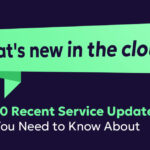
Building a Cloud Center of Excellence: What You Need to Know

CEO and Co-founder
If you call yourself a Cloud Center of Excellence, you’re setting the bar pretty high from day one. So that it doesn’t fall flat on its face, with all of its friends calling it a Cloud Center of Mediocrity – let’s go through some best practices for success.
What Exactly Is a Cloud Center of Excellence?
The impetus behind your cloud growth is likely to come from a few choice stakeholders. This could be executive sponsorship coming from the CIO, a drive for a more agile way of working directed by the DevOps teams, all the way to a cost-saving initiative from the VP of Finance. All ideas have to originate somewhere, but the sooner you can get everyone in the organization on board the better.
Cloud-enabled transformation requires a lot of different skills, and these tend to live in many different places around the organization. Without the expertise of multiple stakeholders, and without buy-in from your employees on the ground-up as well as the C-suite from the top-down, you’re going to struggle to get a successful cloud strategy up and running.
As a centralized function within the organization, many companies have adopted the best-practice of developing a Cloud Center of Excellence (CCoE), a team that is fully dedicated to creating the practices, frameworks and processes for cloud operations across the business. This team should comprise a diverse group of experts who work in different functions across the organization, including technical and business stakeholders, those with a keen focus on security or cost-control, and those at different seniority levels of the business. (No need to invite Jill who works in the cafeteria though, her cloud expertise is limited to the texture of those awesome mashed potatoes she serves up on a Wednesday.)
What are the Goals of a Cloud Center of Excellence?
- Choosing and implementing the right policies for financial, operational, and risk management.
- Assisting the company in choosing the right cloud solutions, and,
- Creating a community for sharing best-practices, improving cloud knowledge, and performing cloud outreach across the business.
Practical Steps for Creating a Successful CCoE
When you’re building out your organizational goals and your initial charter for your Cloud Center of Excellence, here are some best-practices that can help to guide your vision.
Make sure everyone is at the table
Your Cloud Center of Excellence will be its own function, made up of all the stakeholders who will implement the CIO or the CTOs’ cloud vision. Rather than an individual team going for help or support from another once they have decided on what they want, the CCoE can lead the development of cross-functional cloud initiatives, such as implementing a security initiative, maintaining cloud compliance, or provisioning a development environment. As such, you need to make sure that you’ve tagged everyone relevant and that your CCoE is inhabited by solution architects, program and project managers, finance gurus, compliance and security governance experts, and at least a couple of humans who know a thing or two about automation and the technical platform itself.
Look for some low-hanging fruit
People tend to like the idea of the cloud, but it can’t please everyone – it’s not Michelle Obama. It’s always a good idea to start out with some early quick wins that can prove your worth, whether it’s a lift and shift application migration, an easy cost-saving project that shuts down some idle instances or a switch in SaaS vendor to one that includes a boost to your compliance initiatives.
You can travel a great distance with a quick win, getting teams talking about the cloud, showcasing what you can achieve to the C-suite, and garnering confidence in your CCoE to get you to your next project.
Lean on FinOps methodologies
Costs are always going to be a factor, especially when your CCoE is likely to be a cost-center for the business in and of itself. Prove your worth by recommending FinOps practices widely through your outreach, especially for departments that usually aren’t cost-conscious. Communicate to these teams that cost-optimization is a full company initiative, and that the expectations on their budgets will be as high as the expectations on their innovation.
Reiterate to the business that FinOps isn’t about tightening the belt and reducing people’s cloud spend, it’s about understanding, controlling and forecasting what the organization is spending on the cloud. This will mean channelling greater investment in some directions, as well as being smarter about where the budget is currently being misused.
Focus on organizational goals
If you’re doing a CCoE right, you’re going to have a lot of people’s roadmaps to juggle. Remember that your CCoE should belong to everyone, but ultimately you need it to align with the vision of the business if you want leadership buy-in.
If a cloud initiative is a big financial ask and the C-suite is focused on cutting costs this quarter – it may need to wait. Conversely, if you know that high up on the organizational agenda is speeding up time to market against the competition, zero in on the teams who are banging down your door for quicker ways to get features out the door.
Establish a community of practice
This is a really fancy way of saying “put a meeting in everyone’s diary”. A community of practice provides an open forum for discussion, both for the CCoE itself – and for any stakeholders who want to skip the meeting that clashes with this one.
Bring in external speakers who can share their expertise, use the time for cloud skills training, open up the floor to ideas and challenges, and make it an event that people look forward to attending. If all else fails – bring croissants.
Interested in FinOps? Sounds like we’re going to have a lot in common. Let’s talk!
Related Articles
-
Cloud Updates – September 2024
October 16, 2024 -
 This is why modern finance professionals must understand Cloud FinOps
This is why modern finance professionals must understand Cloud FinOps
September 19, 2024 -
 Zesty expands Insights with new cost-saving features for AWS services
Zesty expands Insights with new cost-saving features for AWS services
September 17, 2024 -
 Cloud Updates – August 2024
Cloud Updates – August 2024
September 12, 2024 -
 Zesty Disk now optimizes AWS EBS costs across all major operating systems
Zesty Disk now optimizes AWS EBS costs across all major operating systems
August 28, 2024




